24th Evacuation Hospital Unit History

Colonel Carl M. Rylander, Commanding Officer, 24th Evacuation Hospital (1942-1945).
Introduction & Activation:
The 24th Evacuation Hospital was activated June 15, 1942 at Fort Custer, Battle Creek, Michigan. The initial complement was 1 Officer and 23 Enlisted Men transferred from the 23d Evacuation Hospital at Fort Custer (Military Police Replacement Training Center –ed). Colonel Rex Bolend, MC, was assigned as the first Commanding Officer. After moving by train to Camp Rucker, Ozark, Alabama (Division Camp –ed), the group dedicated most of its time to clean-up details, and it looked as though the men were destined to free all the barracks and mess halls in camp from dirt and rubbish before settling down. Being limited in numbers, the details had to be divided among themselves, so it was a familiar sight to see sergeants doing their own KP, walking guard, cleaning latrines, along with the lower ranks. After several false alarms, on a hot afternoon of 28 July 1942, a train arrived with 128 bright-shining rookies. These EM assigned to fill the complement joined the unit from the Reception Center at Fort Dix, Wrightstown, New Jersey (Training & Pre-Staging Center). After arrival, the men were billeted in three separate barracks and Basic Training got under way. Classes were started, followed by heavy tent pitching, bivouacs, night and day marches, tear gas attacks, live-fire training, etc. With a little more than a month gone by, the unit started to break up for Specialist Training, with small groups departing for Surgical Technician – Medical Technician – X-Ray Technician – and Cooks’ and Bakers’ Schools. A Clerk School was started in the unit itself, followed by Drivers’ Classes for a number of Enlisted personnel.
The unit then moved to Camp Blanding, Starke, Florida (Infantry Replacement Training Center –ed), where it arrived on October 1, 1942. At that time it only had a strength of 10 Officers and 145 EM. After settling down Basic Training continued in earnest with more hikes, bivouacs, and field ‘problems’. By the end of October most men had returned from Specialist Schools and some new men joined the unit. Colonel R. Bolend left the unit on November, 12 1942 to take command of the 21st Evacuation Hospital (which would embark for Guadalcanal on August 29, 1943) affiliated to the Oklahoma School of Medicine, Oklahoma City and recently activated on August 17, 1942, as he had been on the staff there, and the same month Colonel Carl M. Rylander, MC, took over command. The remaining commissioned Officers joined the unit whilst in Florida and on November 7 a further 125 Enlisted Men arrived from Reception Centers at Fort Benjamin Harrison, Indianapolis, Indiana (Finance Replacement Training Center –ed), and Fort Thomas, Newport, Kentucky (Induction Center –ed). The 24th was initially established as a 750-bed Evacuation Hospital but was later reorganized to make it ‘motorized’ and once more again in 1943 to make it ‘semi-mobile’ with 400 beds. Overnight bivouacs were cold in Florida, when being organized under blackout conditions and no fires.
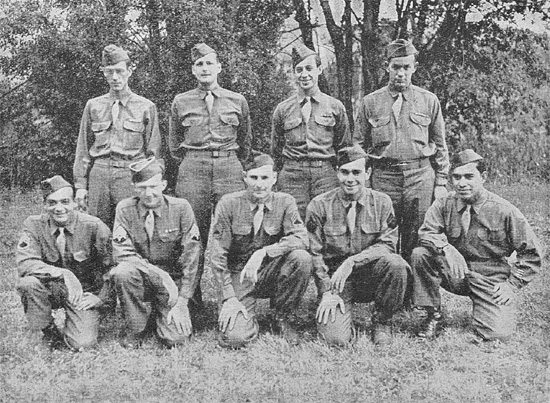
Personnel of the Registrar’s Office and Receiving Section, 24th Evacuation Hospital.
Basic Training was completed February 1943 and unit training finalized by May 1943. In the early months of 1943, the 24th Evac lost several men to units that were alerted for movement overseas. In return, new EM were assigned and joined the unit from various Schools. Some of the Technicians were now placed on SD at the Camp’s Station Hospital to get practical experience. The last days spent at Camp Blanding were very busy ones, packing supplies, marking crates, loading boxcars, and preparing the individual gear and unit equipment for the coming maneuvers. In the meantime new Officers were joining the outfit and a final inspection was scheduled by the Camp Commander. On June 15, 1943, the Hospital departed from Camp Blanding to take part in the Second Army Maneuvers in Tennessee, having meanwhile been augmented by the first half of its complement of Nurses before departure. 19 ANC Officers lead by Alice Ensor arrived June 23 to endure bravely all that the elements had to offer. The wilderness, the rain, the flies, produced visions to many of the pioneers who blazed the trails many years before. On July 2, the group moved slowly to their first operational area near the crossroads village of Castillian Springs, where the hospital was set up. The first patients started trickling in until they formed a torrent of sick and injured men that seemed endless. It gradually became a routine with the staff and personnel working, sleeping, eating, and working, and on the third day of maneuvers the hospital reached its peak census receiving 182 patients. Bivouacs changed, and on July 12, the unit moved again, to a little hamlet called Liberty; followed by yet another move on July 29, to Cookeville. This was a complete change of scenery, instead of rocks, sand, and loads of yellow dust, they ended up in an area with a seething mass of undergrowth and forests which had to be cleared in order to set up the hospital; one advantage was that the men learned to camouflage their installations, and the trees and shrubs helped turn the site into a pleasant cool refuge from the summer sun. On August 25, the organization moved to Gallatin, which proved to be the most pleasant area they stayed at during the field exercises. The second phase of the Tennessee Maneuvers ended on August 28, 1943, with well-earned immediate furloughs for 40% of the personnel, and another set of furloughs for another 40% of the men on September 5, while the remaining 20% were left to handle the daily duties of the hospital. One last move took place to Lebanon, where after a period of 2 days of operation, the unit was alerted for movement. The 3 months of maneuvers were over including the long days and nights of work, the changing weather and terrain, and the humble living conditions. The organization remained in Tennessee, supporting the many units and troops taking part in the Second United States Army Maneuvers, until September 18, 1943 when it was transferred to Camp Tyson, Paris, Tennessee (Barrage Balloon Training Center).
Preparation for Overseas Movement:
Once over there, the Hospital started preparations for overseas movement and the second batch of Nurses joined the unit. Captain Alice Ensor, ANC, became Chief Nurse. At first, the EM were quartered in a WAC barrack and later were moved to permanent quarters which seemed a little disappointing as they did not approximate the luxury of the unit’s former home. Preparations were begun at once, and those who thought that the old routine had been left at Camp Blanding, were in for a surprise. Once more the dusty monotony of the drill field, the many hikes, the drowsy drone of classes and the weekly routine of pitching and striking the hospital tentage were back. Fortunately there were movies, the PX, and the weekly passes to look forward to. In December, the tempo of preparations increased, including the endless showdowns, accompanied by distribution of clothing and special equipment, the physical inspections, and the immunization shots… More exercises were introduced, such as the infiltration course, the forced marches, etc. Administration and paperwork had to be updated, rosters completed, followed by more inspections.
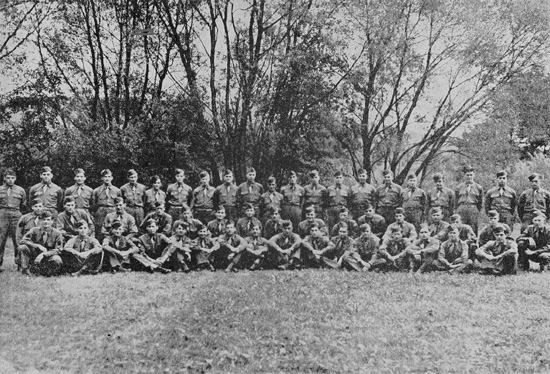
Group picture illustrating personnel of the Ward Section, 24th Evacuation Hospital.
The 24th Evac Hosp completed POM by the end of 1943 and awaited movement orders; all hospital equipment had been withdrawn and it only possessed organizational equipment that was to accompany the unit overseas. For the first nine days of 1944 it prepared to move to a Staging Area and on January 10, 1944 it departed for Camp Kilmer, Stelton, New Jersey (Staging Area for NY P/E –ed). Two days later, after a long train ride, it arrived and joined other units in the final stage of being processed for the dangerous journey overseas. The period consisted of showdown inspections for missing items of clothing, physical examinations and inoculations, training in abandon ship and boat drill. The process which lasted 10 days was well managed but hurried, and the checks of personnel, records and equipment and the briefings went without a hitch. Passes were given to all.
United Kingdom:
Two Medical Officers were detached to accompany other shipments but the balance of the unit left the staging camp on January 21, 1944 and made the short trip to the New York Port of Embarkation at Brooklyn to board ship NY36, the ‘Queen Mary’ at 2345 hours. Once within the huge vessel, the men were ordered down up to D-deck which could easily hold some 500 odd men. Once down with well-stuffed duffel bags and overloaded packs and gear, the men were assigned a fixed place in the steel frames and canvas pallets hanging in tiers of three. There was a washroom close by and a white latrine a bit further, with a little stuffy shower room dispensing only salt water. The trip to Scotland was uneventful and the ship docked at Greenock, the port of Glasgow on the Clyde on January 29, 1944. Around 1700 hours the unit transferred to lighters to cross to dry land and then boarded trains for the trip south to Cheddar in Somerset. Sometimes during the night the train stopped at a British Red Cross canteen somewhere on the bleak moors, where hot coffee, donuts, and meatpies were distributed. During stops, ARC girls entered the railcars passing out free cigarettes (donated by the American Legion, Amarillo, Texas). The men got a glimpse of bomb-battered Bristol on the way.
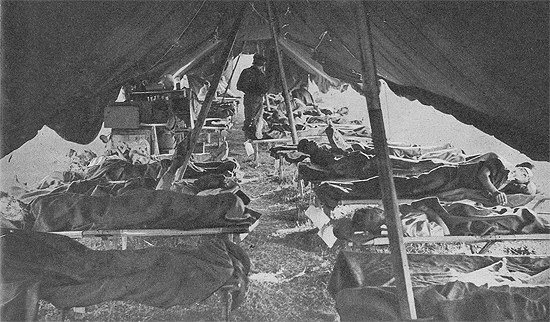
Patients resting on folding cots in one of the tented wards of the 24th Evacuation Hospital.
Cheddar was a small village in the lee of the Mendip Hills, Somerset, and famous for its Ebbor Gorge and the cheese to which it had given its name. Upon arrival, this was 1000 hours, January 30, 1944, the 24th Evac Hosp was met by the preparation party from another Evacuation Hospital and they quickly settled into their new surroundings. It was experienced that the hardest thing to get acquainted to was the currency, and everyone hoped that the locals would be fair and honest and wouldn’t cheat too much! Drinking was something odd, and it looked like the British didn’t know what beer was. They seemed to only have ‘mild & bitter’. A lot could be said for and against the English; yet the men couldn’t find a nicer, more cooperative and more hospitable people. Officers and Enlisted personnel were quartered in separate requisitioned houses whilst the nurses were billeted with families in their homes. A former restaurant in the village was used for kitchen and mess hall. The unit immediately started training, especially in setting up a unit in the field, and regular classes were run. Some of the members of the Hospital unit attended schools run by The Surgeon General, ETOUSA. The unit and personal equipment which had been shipped with the unit only arrived two weeks after the unit reached Cheddar and the personal equipment was found to have been rifled for valuables. The Hospital equipment arrived shortly after the unit but as it was all new, it required quite some preparation before it could be effectively of use. Tents had to be wired for electricity, supplies had to be sorted and repackaged, tables and benches had to be built, linings for the operation room and blackout curtains had to be found and manufactured, and ‘Red Cross’ markers painted and sown. This was largely a repeat of the enhancements made to the equipment used during the Tennessee Maneuvers, which the unit gave up before leaving the United States. Part of the authorized number of vehicles arrived in mid-March and in April the Hospital was joined by a section of a Quartermaster (Mobile) Laundry unit which was to stay with it until October. This extra unit was made up of 1 Officer, 34 Enlisted Men, equipped with 2 van-type laundry trailers.
With plenty of activities on hand, softball and baseball games, showdown inspections, packing and unpacking trucks, wiring tents, pitching heavy tents, filling camouflage nets, doing road marches, attending classes, going to parties and dances, and watching terrible British movies, time went fast and it was soon spring, though it almost rained every day, at least a little. A few changes took place, with the unit losing and gaining some Officers and Enlisted Men. The Hospital was alerted for departure on a new assignment on April 1, 1944. By May 1944, the trucks and equipment were packed and everyone was wondering when? when would the unit move? The townfolk knew, and told the men they would soon move since the rents were only paid till a certain week; moreover there were a lot of empty boxcars in railway yards …
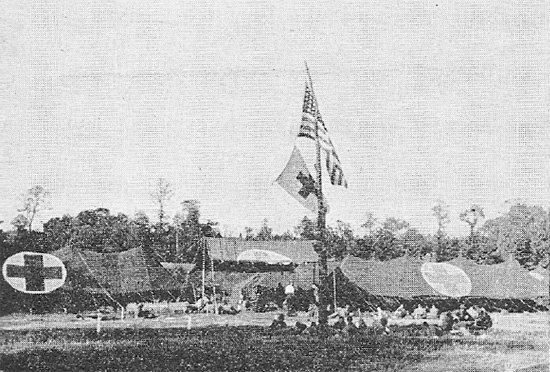
L’Epinay-Tesson, July 1944. Second setup of the 24th Evacuation Hospital in France.
France:
On D-Day, June 6, 1944, the 24th Evacuation Hospital was eagerly awaiting movement orders, however it did not leave Cheddar for its marshalling area until June 8. After an uneventful train ride, the organization then boarded trucks which carried it to the marshalling area at Truro, not far from Falmouth, on the southern coast of England. The unit carried sufficient equipment to operate in a limited capacity on arrival and unit vehicles were to be loaded together on the same ship when they went to the port of Falmouth after an overnight stay in pyramidal tents in the marshalling area at Truro. The following morning, June 9, 1944, the men were issued, water-purifying tablets, field burners, anti-seasickness tablets, K and D rations, and cigarettes. The personnel left the marshalling area at 1800 hours and traveled by motor convoy to Falmouth. A final roll call concluded the preparations and after waiting at the pier for over one hour, the men were finally ordered to board ship at 2100 hours. It was always the classic “hurry up and wait”.
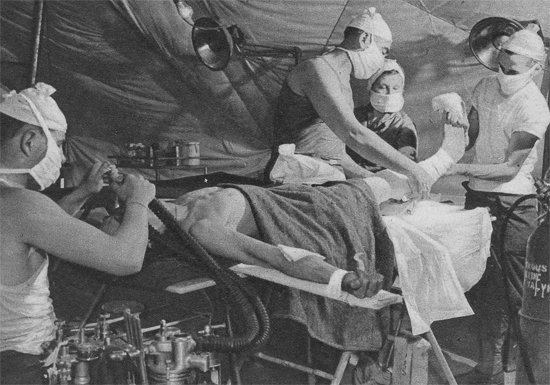
Somewhere in France, partial view illustrating O.R. tent with personnel at work.
The Hospital unit, and a further 200 men, were crowded into a Liberty ship, the MT 245 “Francis Drake” under trying conditions – inadequate sanitary provisions and only K-Rations for food. The ship sailed at 0215 on June 11, 1944, and after regrouping with the rest of the convoy around 1100 hours, it arrived off Omaha Beach early in the morning of June 12. Towards dusk, an LCT pulled alongside and Major Edwards came aboard with orders for the surgical group to land immediately and proceed to the 51st Field Hospital to help the medical staff who was at the point of fatigue. Only 3 vehicles and the surgical section were loaded onto the LCT, while the rest of the unit stayed aboard overnight and only went ashore the next day. Major Edwards had gone on ahead of the unit, landed on D+1, and visited the area selected for setting up the Hospital (La Cambe). The LCT proceeded to Easy Red on Omaha Beach which it reached at approximately 2300 hours. The trucks drove to the shore and the men walked through water knee deep. White tape marked the de-mined areas and the beach was still full of debris and grounded craft. Here and there bodies had been hastily buried, while more had been washed ashore and lay partially buried in the blood-stained sand. The objective was atop a hill or bluff, some two miles inland. It was after midnight when the group finally reached the 51st Field Hospital. The same night the Luftwaffe was out to bomb the ships and an advanced airstrip. For the next two days the surgical team worked almost constantly with an occasional hour of sleep on the ground. On the morning of June 14, it re-joined the remainder of the unit who had stayed aboard the “Francis Drake” until June 13 before landing on the continent by means of an LCT. By 1400 hours, June 14, the Hospital was ready to receive patients with the first one arriving one hour later. It was the first Evacuation Hospital to open behind Omaha Beach, although another unit was ready to take casualties a few hours later, but this one was not nearby. Evacuation Hospitals supporting V and XIX Corps were concentrated around La Cambe (east of Carentan) and Le Molay (north of Caumont).
The equipment which was shipped separately was scattered on the beach and gradually trickled into La Cambe. The patient count soon soared and at midnight June 16 it already reached 453. In addition to the lack of equipment, there was a shortage of personnel, particularly for tasks such as litter bearing where an extra 40 bearers were needed. The 24th Evac Hosp had so many cases they could not treat them all; the most serious cases were given priority but the minor ones were evacuated to a Collecto-Clearing Station (i.e. the 391st or 393d Coll-Clr Cies) on the beach by ambulances borrowed from the 68th Medical Group, and evacuated to England, largely by plane. Sometimes the patients could not be evacuated because of delays caused by the weather and they backed up in the system but generally speaking it worked smoothly. Later on other units acted as holding units, particularly the Field Hospitals or occasionally another Evacuation Hospital. The Field Hospitals (13th Fld Hosp and 51st Fld Hosp) which had arrived before the 24th soon filled up and this necessitated the 24th Evacuation Hospital to take all the serious, non-transportable cases with chest and abdominal injuries. Auxiliary Surgical Teams and some Medical Officers and Nurses from the 45th Evacuation Hospital were attached sporadically to help with the patients’ load which totaled 1,146 admissions whilst stationed at La Cambe.
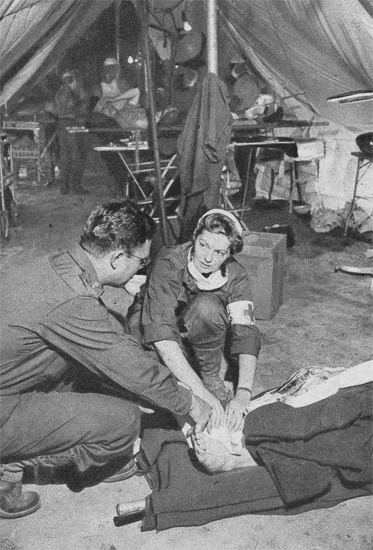
O.R. ward tent. Foreground: a Nurse and a Medical Officer treat a patient’s foot, while Surgeons in the background are operating another patient lying on a litter.
On July 8, the 24th Evac Hosp moved forward approximately ten miles to the vicinity of L’Epinay-Tesson (east of Lison) on the road to St. Lô which was very close to the frontline, only some 3 to 5 miles away. They moved, in the rain, to make room for the 4th Convalescent Hospital (which had landed on June 24) which set up on the vacated site at La Cambe. Although the number of casualties taken during the actual landings had been less than anticipated the troops did not progress inland at the speed expected and at this stage part of the operational medical units were being held in the United Kingdom as there was no space for them in the beachhead. The number of casualties received by the 24th was very high, 2,749 in less than a month, mainly from the fierce fighting in the St. Lô area. Many were severe in nature. Days and nights were filled with the steady thunder of friendly artillery and enemy bombers continued to pay nightly calls over the fields. The Hospital was augmented by the attachment of Auxiliary Surgical Teams and an auxiliary X-Ray unit. A Clearing Company and a Collecting Company set up in an adjacent field and took over its convalescent cases. Prisoners of War were used as litter bearers and for KP – the records of the 24th Evac Hosp indicated that they were superior to the Collecting Company personnel in handling litter cases.
After the rapid breakout of the Third United States Army during “Operation Cobra”, the front quickly advanced and the 24th Evac moved forward to the vicinity of Percy on August 6, 1944. Patients were being brought long distances to the Hospital and the setup remained the same with attached units helping to bear the load. Evacuating the patients still required that they be transported back to the beaches and 2 trucks were used to speed this up. In their time in Normandy the Hospital admitted 78 malaria cases, most of whom had picked it up when serving with First Army in North Africa or Sicily. During their stay at Percy, the 24th handled 1,216 admissions and lost 24 patients. No one would forget the EM’s pup tents beneath the old apple trees, the numerous flies and bees which made life miserable and necessitated the use of mosquito bars over the cots, the concussion of friendly ack-ack fire with shrapnel landing everywhere, the visits of Allied brass, the bomber which crashed nearby, the transfer of some of the Officers to the 1st Infantry Division, and the friendly members of other medical units who assisted the 24th Evac at intervals while their units were being set up. The stay in Percy was short for on August 23, the unit already moved to a Medical Unit Concentration Area near Senonches where it did not receive patients but worked on changing to the use of a double ward tent for the operating theater. PWs were returned to enclosures and relaxation and recreation took up much of the time. At Senonches, the organization was established in a wheat field, exposed to a steady wind, frequent rains, and a lack of sunshine; food was 10-in-1 rations, supplemented by tomatoes, carrots, cucumbers, and eggs from stores and neighboring French farms. Leisure time was filled with softball games with the 5th Evacuation Hospital and evenings spent at the 51st Field Hospital; passes were obtained to visit Chartres, and ration trucks even took the lucky ones as far as Paris.
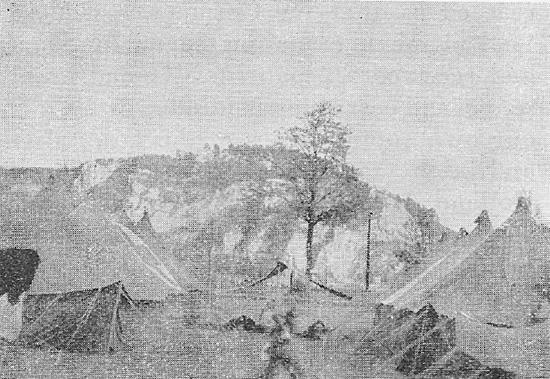
Anhée (near Dinant), Belgium, September 1944. Partial view of the installations of the 24th Evacuation Hospital.
Stations of the 24th Evacuation Hospital – FRANCE
La Cambe, 14 June 1944 > 07 July 1944
L’Epinay-Tesson, 08 July 1944 > 05 August 1944
Percy, 06 August 1944 > 22 August 1944
Senonches, 23 August 1944 > 06 September 1944
La Capelle, 07 September 1944 > 09 September 1944
Belgium:
On September 7, the 24th Evacuation Hospital moved to another new Medical Concentration Area near La Capelle, France, but on arrival they were ordered forward to Anhée (near Dinant), Belgium where they were to set up and receive patients as from September 9, 1944. Again they were a long way from the frontlines and part of the time they acted as a holding unit for patients coming from units closer to the combat area. The work mainly consisted to prepare the many patients coming from various hospitals and clearing stations for air evacuation. In total, 1,810 admissions were handled, with 17 deaths among the patients. A number of wounded German patients were also admitted for treatment. The double ward tent proved more effective than two single operating tents but supply difficulties caused by the distance from the landing beaches made their task harder.
Stations of the 24th Evacuation Hospital – BELGIUM
Anhée, 09 September 1944 > 15 September 1944
Leopoldsburg, 18 September 1944 > 08 October 1944
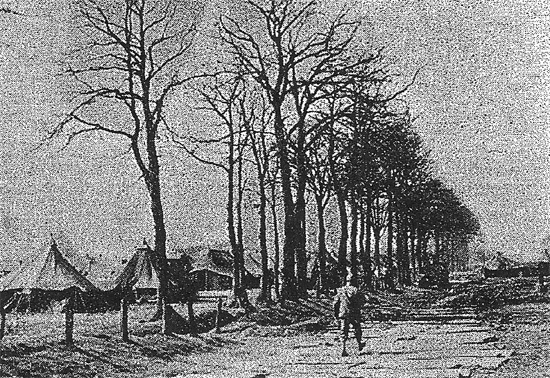
Overview of the 24th Evacuation Hospital’s tentage in the Uden mud. Photograph taken October 1944.
Holland:
Dinant, Belgium was left for an unknown destination, with the organization’s elements traveling in truck and ambulance serials to meet outside of Louvain, Belgium. On September 17, 1944, the unit was attached to the British Second Army to provide support for “Operation Market Garden” and it moved to a location just west of Hechtel crossroads, between Neerpelt (south of the Dutch-Belgian border) and Leopoldsburg. Unit historians describe the location as “a marshy field of heather”. “Market” was the audacious airborne and glider operation designed to capture a carpet of road and rail bridges, culminating in the bridge at Arnhem, which would allow the Allied forces to roll down it, cross two important rivers and swing around the northern end of the Siegfried Line, thus shortening the war. The American Airborne Forces had the task of capturing the two nearest bridges. The 493d Medical Collecting Company, the 662d Medical Clearing Company and the 384th Motor Ambulance Company (in fact used as a Collecting Company) were to reinforce the Hospital, stationed nearby they worked closely together with the 24th Evac
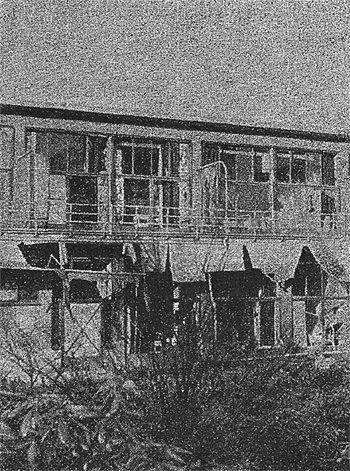
Photograph showing the St. Maarten Kliniek building used as a hospital facility by the 24th in Nijmegen, end October 1944.
The 400-bed 24th Evac Hosp set up on September 18 under command of Colonel Carl M. Rylander, and during the first twenty-four hours of operation it received 512 casualties. The unit’s vehicles moved in by infiltration, journeying from Dijon, France to Leopoldsburg, Belgium, not only through heavy fog and rain, but over roads crowded with British vehicles. 16 ambulances ferried 450 of their first patients from the 101st Airborne Division at Son on September 19, once British XXX Corps had reached the Airborne forces. These included, at 1610 hours, 60 walking wounded who were evacuated to the 24th Evac Hosp by ambulances pertaining to the 493d Medical Collecting Company temporarily attached to the 326th Airborne Medical Company (located at the Son TBC Sanatorium). The following day, British advance units reached the 82d Airborne with 300 accumulated casualties who had been gathered in a school south of Nijmegen. They were evacuated by platoons of the 384th Motor Ambulance Company. It was not feasible for the 24th to move closer to the fighting area because it was feared that the thin gauntlet along which British troops were advancing and through which all casualties had to be evacuated, would be cut by the Germans. Hence many of the casualties received were in a poor state because of the delay in transporting them caused by blocking of the corridor (called “Hell’s Highway”) and shelling of its flanks by the enemy. The unit therefore had to evacuate its patients mainly to British General Hospitals and a triage unit stationed in Diest (northeast of Brussels), using numbers of British and American ambulances. Tragedy struck in the shape of a German fighter which strafed the hospital installations seriously wounding 1st Lieutenant Agatha Raus Kurth, who was on duty in the OR.

Some Nurses of the 24th Evacuation Hospital at Bardenberg, Germany, December 1944.
During the weeks that followed, the unit admitted 1,600 patients from the 101st Airborne and evacuated about 1,300. In addition to functioning as a full Hospital (having performed over 540 operations), the 24th Evac Hosp also furnished medical supplies to the two Airborne Medical Companies also part of the operation (the 307th Abn Med Co and the 326th Abn Med Co). This was difficult at first because the Airborne Divisions were calling for medical supplies which had never been given to the 24th Evac in advance. Consequently they had to be ordered through the British Liaison Officer and flown in specially by eight C-47 cargo planes coming from Cherbourg. Additional supplies had to be requisitioned in order to replenish their own stocks as well. After delivering the goods, the returning planes flew out casualties. In spite of several requests, the Hospital received no reinforcing Auxiliary Surgical Teams during the busiest period of its operation. The surgical staff worked 16 and 18-hour shifts and performed numerous operations, losing 26 patients.
After “Operation Market Garden”, the 24th Evacuation Hospital remained attached to the British Second Army. On October 8, it moved forward to Uden and established itself in a waterlogged field near the town, now opening to receive casualties from both the 82d and 101st Airborne Divisions holding the corridor to Nijmegen. Rain was steady and heavy with mud and water making transportation and evacuation very difficult. As the Airborne Forces were holding ground, rather than attacking, the number of casualties turned out to be less than anticipated and many had already received surgical treatment at units of the 50th Field Hospital attached to the Airborne. This meant that, once more, the 24th was acting as a holding unit and they found this frustrating especially as they thought they could provide better surgical and medical care than the units which had performed the initial surgery. The corridor was much more secure now so it was safe for the Hospital to be located within a couple of miles of the frontline, however it was still far from ideal since a combination of a water table about three feet down and heavy rain made the muddy and boggy location the worst the organization were ever located in. The Hospital was transferred from First United States Army and assigned to Ninth US Army on October 22, with the laundry unit being withdrawn, for service with another First Army unit.

Surgeon at work on a litter patient and apparently trying to make him feel more comfortable by re-arranging splints and bandages.
The 24th Evacuation Hospital remained in Uden until October 26 but with the onset of winter and the need to escape the mud it now moved forward southeast of Nijmegen where it occupied a more modern steel and glass building sitting on a hill in the eastern outskirts of the city. Everyone was glad to leave “’Mudhaven” for better living and operating conditions. This was the building belonging to “Paedologisch Instituut & Ortopaedische Inrichtingen” in Hengstdal, Nijmegen (St. Maarten Kliniek), where the unit would remain from end October to 2 December 1944. The Hospital opened the following day and admitted 1,085 patients whilst there, leaving only on December 2, 1944. During its time in the building, the unit came under attack from German artillery aimed at the nearby Nijmegen bridge as the frontline was still only two miles away. Most of the patients were evacuated to the city of Eindhoven and then taken by air to England. In 1944, 6 individuals from the 24th Evac Hosp were wounded as a result of enemy action including 1 Officer and 2 Nurses(on Sunday before Thanksgiving, a German shell struck one of the wards, seriously wounding Captain Guy A. Myers and 1st Lieutenant Katherine L. Foster; several unit members and patients were slightly wounded. 1st Lieutenant Ann L. Jenkins and Captain Captain Joel T. Woodburn received Certificates of Merit for their cool and efficient work during this emergency).
Stations of the 24th Evacuation Hospital – HOLLAND
Uden, 08 October 1944 > 26 October 1944
Nijmegen, 28 October 1944 > 02 December 1944
During the period of the Holland operation, the Hospital was visited by both Major General Maxwell D. Taylor and Major General James M. Gavin. In fact the medical support and participation in the airborne campaign in Holland became the highlight of the unit’s operation overseas. For almost 2 ½ months, the organization worked under very trying conditions of weather, terrain, gunfire and handled a large number of serious casualties with every member working long hard hours in spite of a shortness in personnel. Three Officers were lost, one on compassionate leave and two because of illness, and several unit members received wounds due to enemy shellfire. In addition, bad weather and lack of rest produced additional illnesses during the campaign. Letters of Commendation were subsequently received from Brigadier Edward Phillips (21st Army Group) and Major Maxwell D. General Taylor (101st Airborne Division), both dated 26 November 1944.
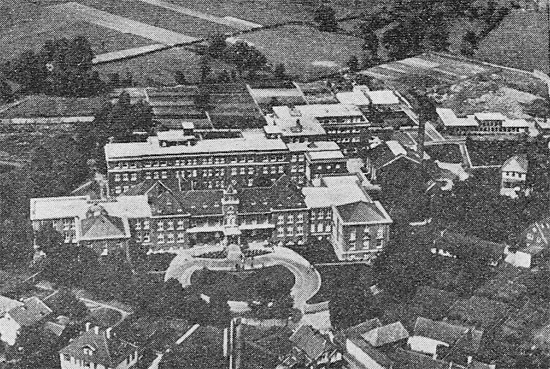
Bardenberg, Germany, February 1945. Aerial view of the buildings housing the 24th Evacuation Hospital.
During 1944 the 24th Evac admitted 12,764 patients and a further 2,150 patients which were not really admitted but were brought in, checked, re-dressed and evacuated to other medical organizations. Of those who were received 21 were dead on admission and a further 204 died while being treated. The standard practice was that wounds were debrided and then loosely packed with vaseline gauze; no great efforts were made to accurately reduce the fractures but they were reduced to what appeared to be a fairly good reduction clinically and a cast applied. Holes in the small intestine were sutured and those in the large gut sutured and then a colostomy was done. The wounds of the abdominal wall were carefully protected from the drainage of the colostomy openings by the use of vaseline gauze. Chest, face and abdominal wounds were sutured but no other wounds. The wounds were closed at hospitals further back in the evacuation chain. The highest number of patients admitted in any one 24-hour period was 512 while located in Leopoldsburg, Belgium, and the highest number of operations that took place in a single day was 175, although it must be said that this required the support of extra Surgical Teams.
In November, the organization (now attached to Ninth United States Army), was on detached duty to the British Second Army. As the 82d and 101st Airborne Divisions had been withdrawn from the line and replaced by Canadian and British troops, the 24th Evac had been instructed as of December 1, 1944, to proceed to St. Truiden, Belgium, to join Ninth US Army and to rest.
Station of the 24th Evacuation Hospital – BELGIUM
St. Truiden, 03 December 1944 > 18 December 1944
Germany:
The next stop was St. Truiden, Belgium, where the unit had a rest based in a school, with the Nurses housed in a nearby Hospital building. The Officers were housed in a private home with the remainder quartered in a building occupied by an Army Air Forces Aid Station. In fact the organization was scattered over an industrial school, a Château, a parochial school, a farmhouse, and a civilian hospital. The period of rest didn’t last long and on December 19 the 24th moved to a Hospital building in Bardenberg (the very FIRST Evacuation Hospital to set up in Germany –ed), a large industrial area (northwest of Aachen), inside Germany. The Hospital unit was to only stay there for 4 days before moving to Brand, again in Germany, just before Christmas, December 23, 1944. At Bardenberg, the buildings of the Miners’ Hospital had been badly damaged but were repaired by an Engineer Battalion. Part of the building was used by a civilian Hospital, and some other American troops. The place lacked electricity and running water; the latter was solved by putting large steel water tanks on the fourth floor and running pipes to each floor, with outlet valves at the end of each one. As the water supply was intermittent and there was not sufficient pressure to get the heated water up to the top floors the installation of booster pumps eventually solved the problem.
No patients were received before the 24th moved. The facility in Brand was in a former Military School which had previously been occupied by another Evacuation Hospital. The task was to provide medical support to Infantry Divisions fighting in the Hürtgen Forest and at the end of the year they were still receiving casualties, although the focus of the fighting had by then switched to the Belgian Ardennes. In Brand the unit was operating in four buildings of which two were used as quarters for the unit’s personnel. Patients were accommodated in the other two buildings with the first floor of one of them housing the shock and pre-operative wards, and the first floor of the other building used for surgery and evacuation cases. This minimized the amount of litter carry upstairs but since moving the patients between the two buildings exposed them to the cold (it was winter) a passageway of three ward tents laced together was made. There was not enough room in the buildings for the receiving section so ‘winterized’ tents were set up in an L-shape. The flow of patients was in one direction from admission to disposition without the necessity to be carried up more than six steps unless they had to be retained in one of the wards on the second floor for some strong medical reason. The 24th Evac Hosp stayed at Brand throughout January 1945 and was the only Evacuation Hospital inside Germany at the time – they were located north of the counter-attack to close the ‘Bulge’ caused by the German offensive in the Ardennes but luckily did not have very heavy casualty loads at that time. All spare equipment was moved back to St. Truiden, Belgium, and the unit was always ready to move to the rear should the military situation demand it. In spite of the severe cold, the snow, the ice, and the uncertain tactical situation, the living quarters were relatively comfortable, and social life remained pleasant.

Litter patient with multiple wounds waiting for treatment, after having been admitted in the Receiving department.
On February 8, 1945, the Canadian First Army launched “Operation Veritable”, a major attack south- east from Nijmegen, Holland, between the River Meuse and the River Rhine. The latter was reached February 14. A converging thrust by the Ninth US Army, called “Operation Grenade”, crossed the River Roer on February 23. On March 1, Ninth United States Army captured München-Gladbach and Rheydt, while a spearhead of the 2d Armored Division reached the Rhine near Neuss. The two advances linked up at Geldern, Germany, on March 3. Two days later the Allies had pressed to the Rhine from opposite Düsseldorf northward, leaving only a small German bridgehead at Xanten-Wesel. The Canadians eliminated this pocket on March 10. Meanwhile, to the south, the left wing of First Army under Courtney H. Hodges attacked toward Cologne on February 23 to cover Ninth Army’s right flank. This offensive swept across the Rhine plain, while George S. Patton’s Third Army punched its way through the Siegfried Line north of the Moselle River.
On February 9, 1945, the Hospital moved eleven miles north, once more to Bardenberg and back into the building that it had briefly occupied before. This provided space for 150 German civilians and staff in their own Hospital with the personnel and 400 beds of the 24th Evac Hosp in a layout that allowed an easy through-flow from the front to the back of the building – and this time the elevators worked! Pre-operative, shock, operating rooms, x-ray and wards for those being in need of immediate treatment were all on the first floor and only the pre-operative ward for ambulatory patients was on the second floor. This layout and wheeled litters minimized the amount of carrying and transferring patients throughout the hospital building. Two operating rooms were set up side by side and the Chief of Orthopedic Surgery could supervise both from the corridor between them, with five tables in one room and two in another. It was the best building that the 24th ever occupied in its time in the ETO. The Hospital was the most advanced in Germany of those attached to Ninth United States Army and was in place for rendering the necessary medical support of the campaign to cross the River Ruhr. A continuous rumble of artillery announced the start of this new Allied offensive and on February 23, the first casualties began to arrive. It was a busy period but never fully stretched, with the organization handling 1,976 patients in 31 days of operation. 37 deaths were recorded in the same period.
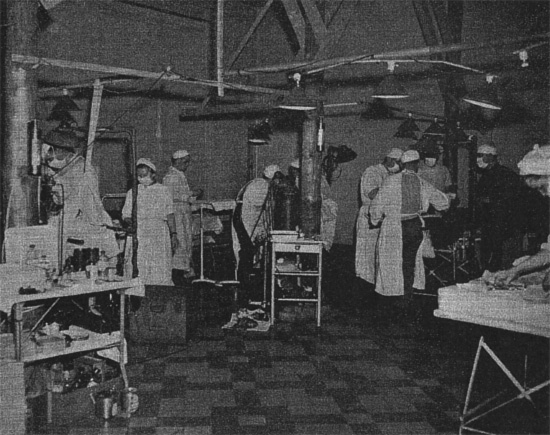
View of the Operating Room at the 24th Evacuation Hospital during the unit’s time in Bardenberg. Picture taken February 1945.
The Hospital closed on March 7 and moved to Straelen in order to be ready for the push across the River Rhine. The whole country was low and wet but the unit set up on the site of a German working camp. Access was easy for it had gravel roads and concrete paths; unfortunately, most of all the buildings had been knocked down. The buildings were salvaged and the remains pieced together to be used for messes, recreation, showers and supply rooms, but the men had to sleep in tents. The unit set up for a short rest period awaiting the main Allied drive across the River Rhine.
In the north, British Second Army plunged across the River Rhine at Wesel on March 23. Aided by a mass drop of American 17th and British 6th Airborne Divisions (“Operation Varsity”), Allied forces pressed eastward and on March 28, near Haltern, broke out on the North German Plain. Ninth Army began crossing on the right on March 24 and five days later the Hospital was able to cross the Rhine to join them, setting up in a field at Peddenberg, about four miles east of Wesel. On the day of reconnaissance it was close to the frontlines but by the time the unit reached its location, it was a long way back given the rapid pace of the advance. Bombs dropped near a convoy of trucks of the unit which were being used to ferry another outfit, knocked out 2 badly-needed trucks and slightly wounded 2 of the drivers belonging to the 24th.
The Hospital was under tentage once more as there were no suitable buildings available. The location was nevertheless ideal except that the grounds were very wet, as everywhere. The ambulance haul was up to 120 miles from the front and that to the rear was also long so there was always a shortage of transportation. The unit could keep up with the work but were worried about the availability of beds because of this. The other major challenge at Peddenberg was mud; on arrival the Engineers were requested to construct roads but before they could arrive, the unit improvised, using rubble from Wesel and sand for roads to consolidate the receiving section, and wide boards to strengthen the walkways. Squad Tents and cots for personnel were welcome but as soon as they were set up it started to rain heavily.
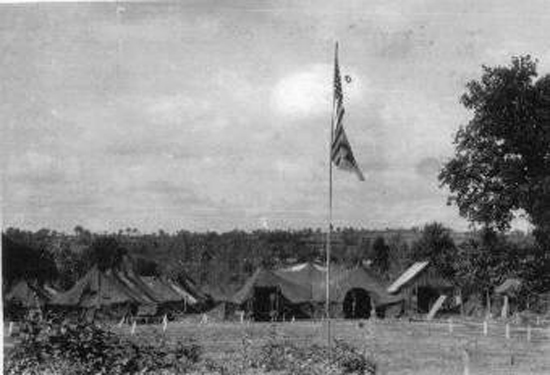
End March 1945, partial view of the 24th Evac under tentage in Germany.
One of the prime Allied objectives in their sweep across western Germany was the industrial center of the Ruhr, along the middle Rhine. General Dwight D. Eisenhower’s forces closed to the Rhine in March 1945 and the mission of holding the west bank opposite the Ruhr, from Bonn north to Duisburg, was then assigned to the Fifteenth United States Army. Fifteen miles south of Bonn, General Courtney H. Hodges’ First Army struck east from its Remagen bridgehead on March 25. Reaching Marburg three days later, VII Corps suddenly wheeled north-east toward Lippstadt, averaging 30 miles a day. Meanwhile, along the north side of the Ruhr, XIX Corps under command of Lieutenant General William Simpson’s Ninth Army drove up the River Lippe, along the northern edge of the Ruhr also heading for Lippstadt. On April 1, the two American columns, the Ninth’s 2d Armored Division and the First’s 3d Armored Division linked up, encircling the Ruhr.
Trapped inside the “Ruhr Pocket” of some 4,000 square miles was Field Marshal Walther Model with most of his Fifth Panzer and Fifteenth Armies, plus an additional 100,000 miscellaneous troops. Unable to break out, the Nazis nevertheless resisted fiercely, hoping to slow down the main Allied offensive. General Omar N. Bradley, now directing both Ninth and First Armies, ordered the eastward drive continued, leaving only two Corps from each Army to reduce the pocket. In the north, XVI Corps and part of XIX Corps of Simpson’s Ninth Army pressed inward toward the River Ruhr. Hodges’ III and XVIII Corps hammered at the eastern and southern sides. By April 14, the shrinking pocket had been split in two by a north-south attack. During the next four days German troops began to surrender en masse, while Model reportedly committed suicide. Resistance ended on April 18, 1945, with the final capitulation of 317,000 prisoners, including 30 Generals. This was the greatest enemy mass surrender of World War II.
On April 10, the unit moved forward again; preceded first by an advance team which selected a location and then followed by an advance detail which went ahead and set up tents for personnel, a partial kitchen and the receiving section. The efficiency of this moving-and-installation process improved with a lot of practice and in one move the entire convoy arrived and four hours later personnel were ready with patients able to be admitted, operated on and given post-operative care. This important process was much easier in tents than in buildings as a setup in buildings often required more time to adapt to the layout available and necessitated more labor to get organized as the building’s configuration often hampered an efficient flow of patients. The new site was at Esperde, in a field but in picturesque surroundings where the outfit moved in the wake of the 2d Armored Division. Again it was near the front where the site was chosen and all German soldiers had not been cleared from the woods nearby. Although the front moved rapidly at this stage of the war armed Germans were seen two miles away when the Hospital was established but the 24th was never molested. The Hospital started to receive Allied personnel from some Prisoner of War camps which had been overrun. All were almost starving, and hosting lice, and some had signs of tuberculosis and other diseases. The RAMPs were weak, emaciated and sick showing evident effects of obvious German neglect and maltreatment!
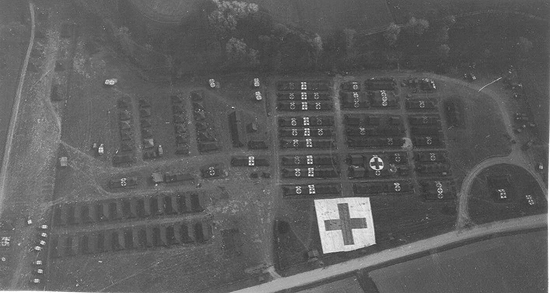
Esperde, April 1945, aerial view of the Hospital. Note the different types of GC recognition symbols (square and circular), as well as the very large ground marker used for aerial recognition.
Leaving troops to hold the northern face of the pocket, Simpson drove eastward, captured Hanover on April 9 and, after a vicious fight at Magdeburg, reached the River Elbe on April 11. On April 18, his forces took Magdeburg. On his right Hodges’ First Army cleaned out an SS unit at Paderborn, captured Kassel on April 2, and, driving further forward, took Leipzig on April 19. Six days later a 69th Infantry Division patrol from V Corps met a Russian spearhead at Torgau on the River Elbe. The Western and Eastern Fronts had linked up, shattering Kesselring’s defenses and cutting Germany in two.
By April 26, the unit closed and moved to Stetterdorf, near Ulzen where they were to bivouac and be prepared to move again to support the drive to the Elbe by XVIII Airborne Corps. The trucks were not unpacked and the advance detail left on May 3 and crossed the Elbe, setting up near Wittenberg. The first part of the Hospital was set up but the Germans were surrendering so the advance section moved back to its original area. The roads were filled with all sorts of transport carrying Germans back and few US Army vehicles were seen.
VE-Day was a festive day, although stationed in a field in Germany, far away from home and amidst thousands of trudging homeless Germans and foreigners, the unit was a bit lost. However, on that day a very well attended service was held in the double ward movie tent at 1330. After the service, everyone went to his/her respective tent where the planning for the evening party was started. Food was excellent, singing plentiful, and sports and games were in full swing the following afternoons, followed by nightly movies. The organization enjoyed a few days of rest and relaxation, with some Officers, Nurses, and Enlisted personnel taking flights and extra sightseeing trips.
The 24th Evac received an official Letter of Commendation signed by Lieutenant General Walter H. Simpson, CG, Ninth US Army, dated 2 May 1945.
The Chief of the Medical Service was in charge of all of the wards and as the preponderance of cases when there was active fighting nearby were surgical in nature it allowed the Surgeons to concentrate on the operating room. This also meant that treatment for shock received priority on the wards and pre and post-operative care was carried out well. This was particularly important in January and February of 1945 when many cases of mine and booby-trap injuries came in. The traumatic amputations brought about the rapid onset of shock and the doctors fought to bring the patient out of shock and keep him out, using whole blood and operating on patients with low blood pressure rather than wait. When the fighting nearby reduced, the number of medical cases increased. Returning patients to their units presented a constant problem; often the units had moved on and transport to take men to their units or to the Replacement Pools was often scanty, requiring the 24th to use its own trucks and ambulances, or borrow these from friendly units.
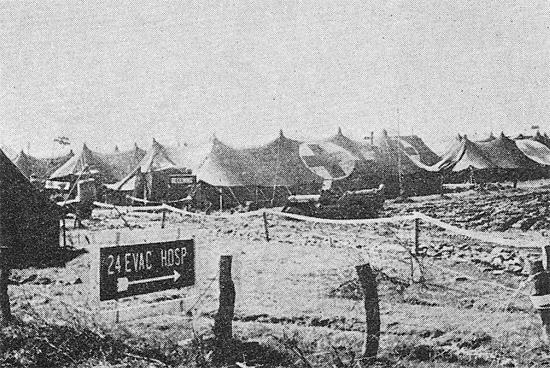
Peddenberg setup, after crossing the Rhine River, Germany, April 1945. Partial view of the
installations of the 24th Evacuation Hospital.
Shortly after the German surrender the 24th Evacuation Hospital was on the move once more, this time to the St. Joseph Stift Krankenhaus in Bremen where it used the existing Hospital buildings and became more settled in nature. The organization was transferred from Ninth United States Army control to Seventh United States Army on June 1 and was now supporting the 29th Infantry Division in the Bremen Enclave, acting as a Station Hospital. The four-story building was also in use as a German civilian hospital and it also had a large four-story air-raid bunker which was attached to the rear wing and used by the Supply Department. The layout allowed a good flow from arrival in the front entrance with wards on upper floors as well as the Enlisted Men’s accommodation. The Officers and Nurses were housed in private homes about a mile away with a bus shuttle service between the two sites. There was even a movie theater in a tent to the back of the buildings and the 2 Red Cross workers who had accompanied the 24th through all its locations were given good facilities for their activities. The Hospital facilities were fine but suffered from the slow re-establishment of civilian services such as laundry, although water and electricity were soon connected and coal was readily available. The Germans evacuated 500 soldiers from the Hospital before the unit arrived but some could not be moved and stayed while the 24th became operational. Released DPs and German civilians were used to help run the large buildings and for minor duties such as cleaning and work details.
The St. Joseph Stift Krankenhaus was taken over by the 115th Evacuation Hospital on July 17, as they were a Category I unit (scheduled to stay on as Occupation Forces in Germany). So, the 24th Evac Hosp left for a tented location at Erda, near Gießen and Marburg. It was a lonely area but the weather was beautiful. All personnel with more than 85 points were transferred to the 97th Evacuation Hospital to return to the US, while the remaining personnel moved to a sloping apple orchard at Ober-Mörlen, near XIX Corps and USFET Headquarters in Frankfurt-am-Main, both of which had excellent recreation facilities and programs which could be used by all. However, the war with Japan ended while the 24th Evac was staging here and they changed from Strategic Reserve status to Active status. A move quickly followed on August 27 to Rotenburg, an area under control of the 3d Infantry Division. After arrival, the Hospital took over a facility in the Jacob Grimm High School from the 44th Evacuation Hospital which was returning to the Zone of Interior. This was a three-story brick building in a good state of repair but entirely unsuitable for use as a Hospital as it lacked sanitation facilities for patients on the wards. It had been a PW enclosure for British personnel during the war. While operating routine Station Hospital cases the 24th received a group of DPs who had been removed from a train as they were unfit to travel further. Some were tuberculin and others were convalescent amputees. They were cared for in tents outside until it became too cold and were then subsequently moved inside. Some of the displaced people were still with the organization when it closed for receipt of patients on October 31. They were then evacuated over the next week to another medical facility.
Stations of the 24th Evacuation Hospital – GERMANY
Bardenberg, 19 December 1944 > 22 December 1944
Brand, 23 December 1944 > 08 February 1945
Bardenberg, 09 February 1945 > 07 March 1945
Straelen, 12 March 1945 > 28 March 1945
Peddenberg, 29 March 1945 > 09 April 1945
Esperde, 10 April 1945 > 26 April 1945
Stetterdorf, 28 April 1945 > 19 May 1945 (bivouac)
Bremen, 20 May 1945 > 28 June 1945
Erda, 29 June 1945 > 16 July 1945
Ober-Mörlen, 17 July 1945 > 26 August 1945
Rotenburg, 27 August 1945 > 04 February 1946 (inactivated)
The End:
During the Rotenburg operation, the organization almost became a “baby institution”, as the result of the thrusting of an Hospital Train of Russian DP upon the 24th. A cute little baby boy was born on Sunday morning, September 9, 1945. A first group of 22 personnel were transferred and sent away to other units. After languishing for a period of about four weeks caring for American and Soviet patients, a second group of personnel was lost (partly compensated by the arrival of 16 Nurses and 20 EM). On September 27, at 0930 hours, 3 Officers, 22 Nurses, and 24 EM entrained as members of the 44th Evacuation Hospital group, on the initial leg of their homeward journey. Another group consisting of 17 Officers, 17 Nurses, and about 175 Enlisted Men (including 50 fillers) were now awaiting departure. The new group finally left on October 3, 1945. Meanwhile, 130 personnel had been transferred to the 133d Evacuation Hospital, and 3 Officers went to the 91st Evacuation Hospital.
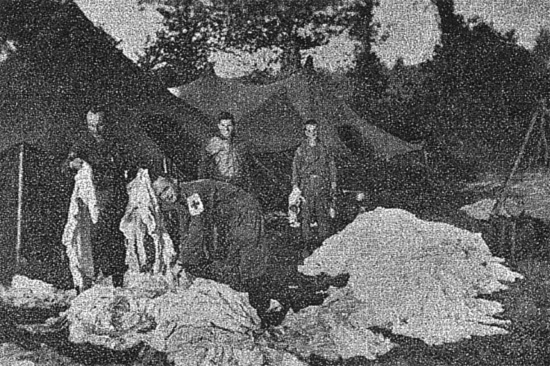
Hospital personnel sort through the daily soiled linen.
On October 3, 1945, the 24th Evacuation Hospital was awarded the “Meritorious Service Unit Plaque”.
The 24th Evacuation Hospital stayed at Rotenburg until February 4, 1946 when it was inactivated, and equipment turned in, records forwarded to Brussels and the remaining personnel transferred out.
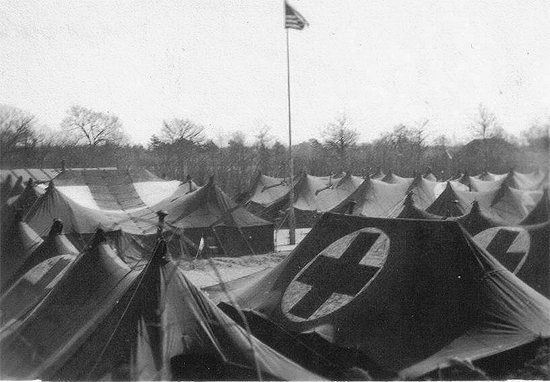
Esperde, April 1945, partial view of the tented Hospital while set up in Germany.
During its time in the ETO the 24th Evac Hosp admitted and treated 19,313 patients of which 98.39% survived as a result of the care given by the unit’s medical personnel. The organization’s drivers toured Europe using about 122,510 gallons of gasoline, and driving approximately 620,742 miles when serving overseas.
Total Admissions per Country – 24th Evacuation Hospital
France – 5, 111 Admissions (123 deaths)
Belgium – 5,242 (54 deaths)
Holland – 1, 908 (17 deaths)
Germany – 7,052 (115 deaths)
Partial Statistics – 24th Evacuation Hospital (June 1944 > June 1945)
Autopsies – 101
Operations – 9,015
X-Rays – 13,161
Morphine Sulfate Injections – 14,160
Prescriptions – 16,245
Laboratory Tests – 18,150
Sulfadiazine Tablets – 315,000
Human Blood Plasma – 2,602,750 cc
Sterile Dextrose Solutions – 3,235,000 cc
Penicillin Units – 1,401,400,000
Campaigns of the 24th Evacuation Hospital
Normandy
Northern France
Rhineland
Central Europe
Roster:
Enlisted Men Roster (1942-1945)
| ADER, Irving M. (Tec 5) AKERS, Hunter M. (Pfc) AKLUS, John F. (Pvt) ALLEY, Walter R. (Pfc) ALMAND, William L. Jr. (Pfc) ALPE, John (Pvt) AMBROSE, Marcelose (Pvt) ANDERSON, Arnold L. (Pfc) ANDERSON, Preston S. (Sgt) ANDERSON, William L. (T/Sgt) APOSPOROS, Peter G. (Pvt) ARBAUGH, Pearly E. (Pvt) ARMACOST, John W. (Tec 5) ARMSTRONG, Norman H. (Pfc) ARTHUR, William C. (Cpl) ATWOOD, Eugene W. (Pfc) BACKER, Nathan (Pfc) BAKER, Carl W. (Pfc) BAKER, Sherman H. (Tec 5) BALCH, Coleman E. (Pfc) BALFOUR, Patrick H. (Pfc) BALOUSKI, Peter P. (Pvt) BARAN, Michael (Pfc) BARBEE, Robert W. (Pfc) BARDINI, Attilio (Tec 5) BARNARD, James H. (Pvt) BARNETT, Henry F. (Pfc) BARRIE, Virgil D. (Tec 4) BASHAM, Golden C. (Pvt) BEBOUT, James I. (Pvt) BELLINA, Angelo (Pvt) BERMAN, Morris (Pfc) BETHUNE, Michael J. (Pvt) BETTS, Bert O. (Tec 5) BEVAQUA, Rosario (Pfc) BICHARD, Henry W. (Pfc) BING, Donald W. (Pvt) BIVIANO, Frank (Tec 5) BLAGER, Overt M. (Pfc) BLAKLEY, Raymond J. (Tec 5) BLANCHETTE, Archie W. (Tec 5) BLANKINSHIP, Keith W. (Pvt) BLESSINGER, Victor L. (Pvt) BOCKELMAN, Harold F. (Pfc) BONCE, Andre E. (Tec 4) BOND, Robert F. (Tec 5) BONGIORNY, Alfred A. (Pfc) BONTJES, Bontje J. (Tec 5) BORJESON, Karl A. (Pvt) BOSTROM, Leonard E. (Pfc) BOWMAN, Arla N. (Pfc) BOWMAN, Maurice H. (S/Sgt) BRADLEY, Gilbert G. (Tec 4) BRILLIANT, Martin (Pvt) BRITTAIN, Manley G. Sr. (Tec 5) BROCK R. J. (Pvt) BROHAN, Maurice D. (Pvt) BROWN, Murray E. (Tec 5) BRUMLEVE, Henry L. Sr. (Pvt) BUCKLEY, Kenneth L. (Pfc) BUMGARDNER, Howard E. (Tec 5) BURDICK, Bennie (Pfc) BURKE, Jack T. (Pvt) BURNS, Joseph F. (Pvt) BUSHARA, Joseph J. (Pfc) BUTLER, Harry H. (Pvt) BYRD, Edward H. (Pvt) BYRD, William H. (Pvt) BYRNE, Gerard (Pvt) BYRNES, Frederick N. (Pvt) |
KOSANOVICH, Alexander (S/Sgt) KOWAL, Steve S. (Pfc) KRAKOWSKY, Philip (Pvt) KRAUSS, Martin B. (Pfc) KREER, Daniel P. (M/Sgt) KRESKO, Stephen (Pvt) KRILEY, Leo P. (Pfc) KUMAGAI, Minoru M. (Cpl) LA GRANDE, Joseph J. (Tec 5) LA MARCA, Joseph (Pvt) LA TOUR, Louis B. (Tec 4) LAMEIRAS, Mariano (Pvt) LANDAU, Sigmund (S/Sgt) LANDFRANC, Carl J. (Tec 5) LEICHTER, Murray (Pvt) LENNON, Robert F. (Tec 5) LEONARD, Douglas A. (Tec 4) LEONG, Wah (Pvt) LEVENFUSS, Paul (Tec 5) LEWIS, Edgar C. (Tec 5) LIGARI, Carmelo (Pvt) LINDLEY, Sylvester (Cpl) LINDSTADT, Henry Jr. (Pvt) LONG, Stanley L. (Sgt) LUEHRS, Lloyd J. (Pfc) LYON, Francis H. (Sgt) MAILLET, Felix P. (Tec 5) MAKOWSKI, James P. (Pfc) MALLOY, Gerald Q. (Tec 5) MANCE, Ernest W. (Tec 5) MANGOT, Michael (Pvt) MARBLE, Floyd C. (Pfc) MARENGO, Roy E. Jr. (Sgt) MARES, Manuel B. (Pvt) MARKUS, Frank W. (Pfc) MARSHKY, Carl J. (Pfc) MARTIN, Charles W. (Pvt) MARTIN, Raymond J. (Sgt) MARTIN, Robert F. (Pfc) MATTINGLY, Louis B. (Pvt) MC ALPIN, Mark N. Jr. (Tec 5) MC CLENNY, Milton S. (Pvt) MC DANIEL, Clifford E. (Pfc) MC GANN, Paul B. (Tec 4) MC GEARY, John F. (Tec 4) MC KENNEY, Patrick (Tec 4) MC LAUGHLIN, Alexander (Pvt) MC LAUGHLIN, Ernest P. (Tec 5) MC MILLIAM, Harry R. (Sgt) MC NIECE, Donald W. (Tec 4) MECCIA, Salvatore (Pfc) MELTZER, Samuel (Pvt) MERRILL, Jesse E. (Pvt) MILLER, Harold (Sgt) MILLER, Robert C. (Pfc) MILLER, Robert F. (Tec 5) MILONE, John (Pvt) MIMUSS, William (Tec 4) MINDEL, Dowain W. (Tec 5) MINER, Walter L. (Pfc) MITCHELL, James L. (Pvt) MITURA, Stephen J. (Sgt) MOLCHAN, John (Tec 5) MOLTER, Albert H. (Pvt) MONTANES, Anastacio M. (Pfc) MOON, William A. (Tec 5) MOORE, Paul W. (Pfc) MRZLEK, Thomas J. (Pfc) MULVAIN, Virgil E. (Pvt) MUÑOZ, Pablo R. (Pfc) |
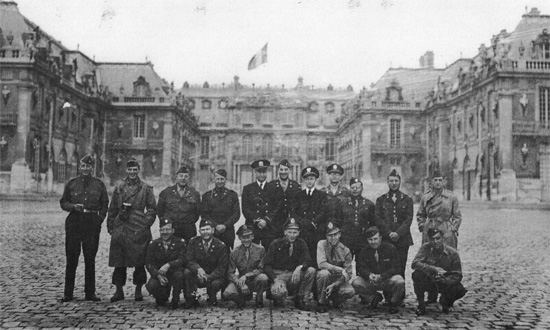
A mixed group of Hospital and Naval Officers pose for a photograph somewhere in Paris.
| CAMBRE, Falsen S. (Cpl) CAMPBELL, J. E. (Pfc) CANNON, Albert E. (Cpl) CARGILL, Curtis E. (Tec 5) CARNAL, Thurman M. (Tec 5) CARRINO, Frank J. (Tec 5) CASE, Joseph E. (Pvt) CASKEY, Earl (Pvt) CASTEL, Rafael (Pvt) CASTLEMAN, James B. (Pfc) CATANZARO, Sam (Pvt) CAUTHRON, Robert C. (Cpl) CAVANAUGH, Robert L. (Pfc) CHAN, Charles K. (Tec 4) CHAN, Wong W. (Tec 5) CHIZMAN, Abraham I. (Pvt) CHRISTEN, Arthur G. (Pfc) CHRISTENSEN, Chris I. (Tec 5) CHRISTIE, Clifford A. (Pfc) CICOLELLA, Joseph (Pvt) CIOTTO, Frank (Pvt) CIRULLI, Angelo (Pvt) CLARIN, Arthur H. (Cpl) CLARK, Lorenzo G. (Pfc) CLARK, Norman H. (Tec 5) CLAUSMAN, Charles J. Jr. (Pvt) CLAY, Gartral M. (Pvt) CLEWIS, Oling R. (Pvt) CLINE, Clinton J. (Pvt) COHEN, Harry (Pvt) COMBS, Monroe G. (Pvt) CONLEE, Gregg A. (Pvt) CONRAD, William F. (Pvt) COOPER, Herman (Tec 4) COX, Charlie W. (Pvt) CRABTREE, Herman L. (Pfc) CRAFT, Howard A. (Tec 5) CRANKER, William R. (S/Sgt) CRAWFORD, James H. (Sgt) CROUTHAMEL, Warren W. (Pfc) CROY, Charles Jr. (Pfc) CSERVITS, John S. (Pfc) CUCCARO, Frank J. (Tec 5) D’AGOSTINO, Joseph (Tec 4) DAGUE, Iwan M. (Tec 5) DAILEY, James W. (Tec 5) DAME, Wilbert W. (Pfc) DANCHO, Michael (Pfc) DANIELS, Nathan B. (Pvt) DARIO, John (Sgt) DARLING, Robert N. (Pfc) DATRI, Marion A. (Cpl) DAUGHERTY, Clifford P. (Pfc) DAVIS, Ben (Pvt) DEC, Walter F. (Pvt) DELLERS, Arthur W. (Tec 5) DERRICK, Rex E. (Pvt) DESERIO, James R. (Pvt) DI MEGLIO, Fabio (Pfc) DIERDORF, John W. (Tec 3) DIGNAN, Charles E. (Pvt) DONDERO, Louis J. (Tec 5) DOODY, Edwin J. (Pvt) DUL, John (Tec 4) DULIN, Harlan K. (Pfc) DUNN, Charles J. (F/Sgt) DUNN, Forest E. (Tec 5) DUPONT, Arnold E. (Tec 5) EHRENBURG, Arnold (Pfc) ELIASSON, Gunnar E. (Pvt) ELLIS, Remus E. (Tec 5) ENNIS, Oscar L. (S/Sgt) ESTRADA, José D. (Pvt) EVANS, Lawrence O. (S/Sgt) EWAN, Joseph D. (Tec 4) FARKAS, Alexander J. (S/Sgt) |
MUSKA, Joseph A. (S/Sgt) MYERS, Alfred H. (Tec 3) NANTISTA, John B. (Pvt) NASSER, Nosser Dean S. (Tec 5) NATTER, Harry L. (Pfc) NEAL, Clair A. (Tec 5) NEWTON, Maurice A. (Pfc) NIELSEN, Frank T. (Pfc) NORRIS, William J. (Tec 4) NORTH, Benjamin J. (Pfc) OBERMARK, Donald R. (Tec 5) OLKO, Stanley J. (S/Sgt) PAIT, Theron B. (Pvt) PALERMO, John (Pvt) PANOS, Thomas E. (Tec 5) PAPA, Vincent (Pfc) PARADEE, William J. (Tec 3) PARRISH, Willie V. (Pvt) PATTERSON, Monan H. (Pfc) PEARCE, Victor V. (Pvt) PEARSON, Carl H. (Cpl) PELLEGRINI, Charles M. (Pvt) PENCE, Edward M. (S/Sgt) PENN, William H. (Pvt) PEOPLES, Preston W. (Pfc) PERKINS, Denver T. (Pfc) PETELN, Carl (Pvt) PETERSON, Robert J. (Tec 5) PETRUZZI, Frank B. (Pvt) PFEIFER, William J. (Pfc) PHILLIPS, Estel E. (Pvt) PHILLIPS, John D. (Tec 5) POMPONIO, Rocco (Tec 5) PORSCHEN, William S. (Pvt) PRYOR, Bornice H. (Tec 4) PUZIO, Michael J. (Tec 5) QUEEN, Robert L. (Cpl) QUICK, Robert P. (Cpl) RACCA, Wiltz (Pfc) RAMSEY, Raymond F. (Pfc) REED, Charles F. (Sgt) REES, Lloyd G. (Tec 5) REESE, Jack R. (Tec 5) REHOR, Carl P. (Tec 5) REIMER, Marvin J. (Pvt) RELLA, Ettore (Tec 3) REYNOLDS, Conrad L. (Pvt) RICKLES, Joseph (Pvt) RIEDERMAN, Norman H. (Tec 4) RIEGE, George L. (Tec 4) ROBERTS, Robert W. (Pvt) ROBERTS, William P. (Sgt) ROBERTSON, William R. (Pvt) ROCKWELL, Kenneth E. (Sgt) RODGERS, Theodore E. (Tec 5) RODICK, Joe T. (Cpl) ROGERS, Vincent P. (Tec 5) ROSE, Lawrence (Pfc) ROSNER, Alex (Pfc) RUSSELL, Harry H. (Pvt) SAKALSKY, George E. (Pvt) SANDEFUR, Melville E. (Pfc) SANDERSON, John R. (Tec 3) SANDLER, Alex (S/Sgt) SARVER, Roy J. (Pvt) SAYE, Gilbert C. (Pvt) SCAGLIONE, John J. (Tec 5) SCHENKMAN, Seymour (Tec 5) SCHEPPER, Wayne C. (Tec 4) SCHMALSTIG, George H. (Tec 5) SCHMITZ, Vincent (Tec 5) SCHMOYER, Luther T. (Pfc) SCHULTZ, Alvin L. (Tec 5) SCHUMACHER, Earl S. (Pvt) SCHUSTAL, Samuel I. (Pfc) SCHUTZ, Francis F. (Tec 5) |
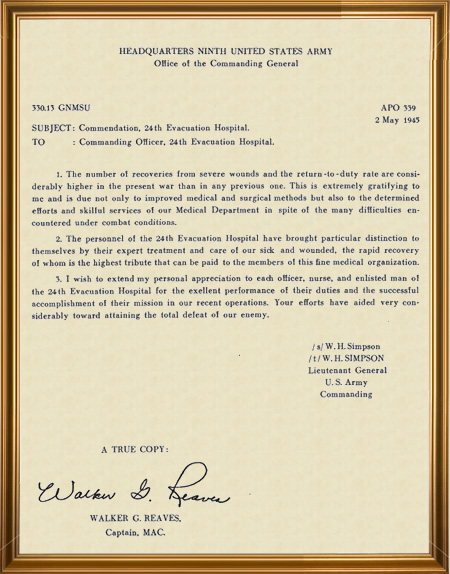
Commendation received by the 24th from the Ninth US Army dated 2 May 1945, congratulating the unit and its personnel on the high number of casualties the facility returned to duty.
|
FAROWICH, Walter (Tec 4) |
SCHWARTZ, Cecil S. (Pvt) SCHWARTZ, Sam B. (Pvt) SCUDERI, James (Sgt) SEID, Samuel (Tec 4) SELTZER, Abraham (Pvt) SHACK, Norman F. (S/Sgt) SHANKS, Albert H. (Pvt) SHAPIRO, Jesse J. (Pvt) SHAW, William J. Jr. (Cpl) SHERMAN, James W. (Tec 3) SHEWMAN, Walter A. (Tec 5) SHIRKEY, James (Cpl) SHRADER, Henry L. (Pvt) SHTOB, Abe (Tec 5) SHUMYLO, George J. Jr. (Pvt) SILVERSTEIN, Leo H. (Pvt) SIMON, Leonard (Pvt) SIMPSON, Merle E. (Pfc) SINCLAIR, John W. (Pfc) SKEMBES, Heorge A. (Pvt) SLADE, Theodore B. (Pvt) SNELL, Sanford L. (Tec 5) SORENSEN, James H. (Tec 5) SPAHR, Edwin G. (S/Sgt) SPELLS, Samuel K. (Pfc) SPENCER, Raymond (Pfc) SPENCER, Tom M. (Cpl) SPINNER, Alex (Pfc) STABLER, Charles W. (Pfc) STARK, Sidney (Tec 4) STEELE, Wylen F. (Tec 5) STEINOUR, Samuel C. (Pvt) STEVENS, Joseph B. (Tec 4) STONE, Cleatus L. (Pvt) STRUTT, Melby W. (Tec 5) SUE, Hom D. (Tec 4) SULLIVAN, Harvey E. (Pvt) SZYMONIK, Walter L. (Tec 5) TASSEY, William V. (Tec 5) TAYLOR, Charles M. (Pvt) THALBERG, Gordon M. (Tec 3) THIM, Benjamin (Pvt) THOMAS, Clifford L. (Pfc) THOMPSON, Harold E. (Pfc) THOMPSON, James W. (Pvt) THORN, Alfred W. (Tec 3) THRONSON, Sidney F. (Cpl) TOEDTER, Howard A. (Pfc) TOLLEY, Fred H. (Pvt) TONN, Warren J. (Pfc) TOOMEY, Myron S. (M/Sgt) TOPJIAN, Robert M. (Pfc) TOPPASS, John O. (Pvt) TRIVETT, Conley E. (Pfc) TROUP, Jack C. (Tec 5) TUCKER, William E. (Pfc) TURIM, Irving A. (Pfc) TURPIN, Foster L. (Tec 5) TWIDWELL, William E. (Pfc) TYLER, Morris (Pfc) TYREE, George M. (Pfc) USHER, Calvin C. (Pfc) VANATTA, Wilson M. (Pvt) VAUGHAN, Hardin (Pvt) VELASQUEZ, Francisco (Pvt) VENESS, Donald R. (Cpl) VIDMAR, Peter F. Jr. (S/Sgt) VINCENT, Gene S. (Pfc) VITANZA, Matthew J. (Pvt) VLOSKY, Milton E. (Tec 5) WALDBERG, John R. (Pvt) WALDRIE, Clayton E. (F/Sgt) WALERIUS, Raymond J. (Tec 4) WALKER, James H. (Pfc) WALSH, William L. (Pvt) WARREN, Harold N. (Tec 4) WASSERMAN, Sheldon (Pfc) WEARLY, Wilbur D. (F/Sgt) WEBB, Ralph W. (Pvt) WHARTON, Ralph W. (Tec 4) WHITE, Philip A. (Tec 4) WILBURN, Thomas N. (Pvt) WILES, Robert W. (Tec 5) WILLISON, George A. (Cpl) WILMS, Arthur (Tec 5) WILSON, Ray (Pvt) WINTERS, Joseph M. (Tec 5) WISOTSKY, George (S/Sgt) WOJTAS, Benjamin M. (M/Sgt) WOODRUM, Mowell L. (Tec 5) WRIGHT, Jennings (Pvt) YOST, George L. Jr. (Pvt) ZANFT, Auram B. (S/Sgt) ZCZYGIEL, Andrew J. (Pfc) ZEIDES, George A. (Pfc) |

Group of 24th Evacuation Hospital Officers and Enlisted personnel during a visit to Paris, France, 1945.
Officers Roster (1942-1945)
|
ANDERSON, Richard S. (Col) BACKENSTOSE Donald J. (Capt) BECKENSTEIN, Harry A. (Capt) BELL, John F. (Capt) BIERNBAUM, Joseph (Capt) BRANDT, Walter S. (1st Lt) BRITT, Walter S. (Capt) BROWN, Brooks G. Jr. (Capt) BROWN, Clifford N. (Maj) CHIMERA, Marion J. (Maj) COLL, James J. (Maj) COLPOYS, William P. Jr. (Maj) CONROY, Edward G. (Capt) COOPER, Samuel S. (Capt) CORBETT, Redmond J. (2d Lt) D’AMANDA, William D. (Capt) DAVIS, Hiram W. (Capt) DEEHAN, James S. II (Capt) DICKINSON, William W. (Capt) DI STEFANO, Grimaldo C. (Capt) DONATO, Marion T. (Maj) EDWARDS, Linus M. Jr. (Maj) ENDERS, Warren H. (Maj) ENKLEWITZ, Morris (Capt) FRIEDMAN, Harry S. (Capt) GRAHAM, Wallace H. (Lt Col) HOGAN, Daniel F. (Capt) HUEY, Thomas F. Jr. (Lt Col) JACOBS, Abraham (Capt) KUNDAHL, Paul C. (Capt) |
KURTH, Russell H. (Capt) LEITNER, Moser J. (1st Lt) LEWIS, James E. Jr. (Capt) LITT, Edward T. (Capt) LODMELL, Elmer A. (Lt Col) MALKIN, Julius S. (2d Lt) MARSHALL, Edward J. (Maj) MARTIN, Herbert (Capt) MORRISON, Philip J. (Capt) MYERS, Guy A. (Capt) NYVALL, Pierre J. (Capt) PATE, William A. (1st Lt) REAVES, Walker G. (Capt) RYLANDER, Carl M. (Col) SACK, Anthony G. (Capt) SCHWARTZBERG, Joseph A. (Capt) SHALDA, James G. (WOJG) SHUMAN, Harold I. (Capt) SLIWINSKI, Wallace F. (Capt) SMALTZ, John E. (Lt Col) TEAHAN, John W. (Capt) UNGER, Max (Capt) VAN DYKE, John J. (Capt) VAN GUNDY, Jack E. (1st Lt) VERNON, Hollis E. (Maj) VESPER, Albert J. (Maj) VIETA, John O. (Capt) WEKALL, Oliver C. (Maj) WILT, Harold L. (Capt) WOODBURN, Joel T. (Capt) |

Personnel of the Supply and Utility Section, 24th Evacuation Hospital.
Nurses Roster (1943-1945)
|
ALLISON, Gertrude L. (1st Lt) AUSTIN, Edith A. (1st Lt) BAKER, Audrey A. (1st Lt) BANKS, Emma C. (1st Lt) BAXTER, Virginia (1st Lt) BEABOUT, Bernadine (1st Lt) BEELOCK, Edith (1st Lt) BENNETT, Elsie (2d Lt) BOWEN, Agnes I. (1st Lt) BRADSHAW, Grace E. (1st Lt) BRILL, Lillian A. (1st Lt) BUCK, Mary E. (2d Lt) CAKE, Margaret L. (1st Lt) CASPER, Adelaide H. (1st Lt) CHAPMAN, Mary A. (1st Lt) CLARKE, Helen K. (1st Lt) COLLINS, Madge W. (2d Lt) COTTRELL, Eva M. (1st Lt) CRAWFORD, Alice G. E. (Capt) DAVIS, Alberta (1st Lt) DOMMA, Pearl A. (1st Lt) DONOFRIO, Doris V. (2d Lt) EMMERT, Ruth M. (2d Lt) FITZPATRICK, Mildred M. (1st Lt) FLEMING, Margaret (1st Lt) FOSTER, Katherine L. (1st Lt) FRAZEE, Naomi O. (1st Lt) FROJD, Mary E. (2d Lt) GATES, Edna (1st Lt) GREENE, Alice G. (2d Lt) HANRAHAN, Helen C. (1st Lt) HARRELL, Frances M. (1st Lt) HENLEY, Sarah E. (1st Lt) HIGINBOTHAM, Eva L. (2d Lt) HOKESON, Dorothy A. (1st Lt) HOPPER, Frances M. (1st Lt) JENKINS, Ann L. (1st Lt) JOHNSON, Sybil (2d Lt) KINNEY, Margaret A. (Capt) LASKY, Yetta J. (2d Lt) LAUER, Mary H. (2d Lt) |
LIGGETT, Lucy J. (2d Lt) LOGUE, Frances R. (2d Lt) LUCKEN, Dorothy (1st Lt) MACLEAN, Dorothy (2d Lt) MACON, Kathryn (1st Lt) McINNIS, Jane K. (2d Lt) McMANUS, Margaret M. (1st Lt) MENOR, Darlyne G. (2d Lt) MILLER, Pauline J. (2d Lt) MOYER, Constance S. (1st Lt) MUNSON, Betty A. (1st Lt) NEWTON, Anne E. (1st Lt) NEWTON, Muriel W. (2d Lt) O’BRIAN, Frances (1st Lt) OVERSTREET, Mildred H. (2d Lt) PESCATORE, Josephine M. (1st Lt) PICCIRILLI, Henrietta Y. (1st Lt) PIETRA, Congetta (1st Lt) POUND, Cornelia B. (1st Lt) PROSSER, Elizabeth (1st Lt) RAITANEN, Olga D. (1st Lt) RAUS, Agatha P. (1st Lt) RICHARDS, Rhoda B. (1st Lt) SANNER, Jean S. (2d Lt) SCHEELS, Charlotte (1st Lt) SCHMIDHAMER, Kathryn A. (1st Lt) SELLERS, Johnnie A. (1st Lt) SHIBICK, Statia T. (1st Lt) STUMP, Lillian (1st Lt) SWEET, Jane (1st Lt) THURMAN, Lynn (1st Lt) WALSH, Gladys M. (1st Lt) WARE, Emma E. (1st Lt) WHITBY, Mary (1st Lt) WILKENA, Valoris (1st Lt) WRIGHT, Hildegarde M. S. (1st Lt) YORK, Lillian (1st Lt) YOUNG, Ruth A. (1st Lt) ZOLAR, Eustine (1st Lt) ZUPA, Kathryn E. (2d Lt) |
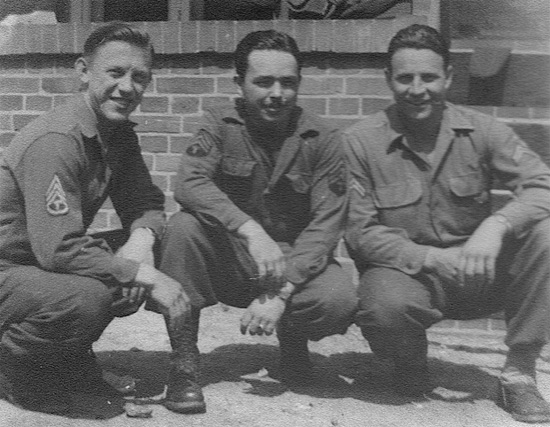
Technician 4th Grade Wayne C. Schepper (center), 24th Evacuation Hospital, with friends. Picture taken in Bremen, Germany, June 1945.
American Red Cross Workers Roster (1943-1945)
|
KELLEY, Louise H. LOGUE, Emily MYERS, Virginia |
PRIEST, Eleanor VIA, Catherine |
We are very grateful to Tony Honeyman, British Historian and Researcher, for having provided us with the basic Unit History of the 24th Evacuation Hospital. Tony also spontaneously shared a number of illustrations which appear in this article. With assistance from Chris Schepper, grandson of Sergeant Wayne C. Schepper (ASN:35563229) who served with the 24th Evacuation Hospital, we were able to add some important data, pictures, and a EM personnel roster. Thank you. Additional material was thankfully received from Stephanie and David Morrison, daughter and son of Captain Philip J. Morrison, who also served with subject Hospital unit.
